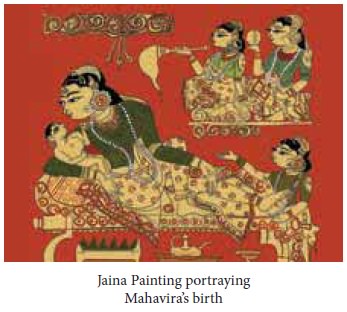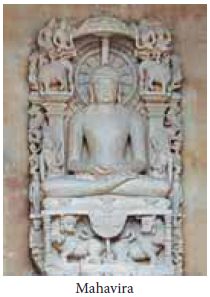Rise of New Religious Sects | History - Jainism | 11th History : Chapter 3 : Rise of Territorial Kingdoms and New Religious Sects
Chapter: 11th History : Chapter 3 : Rise of Territorial Kingdoms and New Religious Sects
Jainism
Jainism
Among the various sects, the sect led by Vardhamana Mahavira (referred to as Nigantha Nataputta by Buddhist texts) bloomed into a religion called Jainism. It was earlier known as Nirgranthas (free from bonds). Mahavira was known as Jina (conqueror) of the soul and hence his sect came to be known as Jainism. According to Jain tradition, Mahavira was not the founder of Jainism, but the last of the 24 Tirthankaras or ‘maker of fords’ (ford means a shallow place in river or stream to allow one to walk across). According to Jaina tradition, Risabha was the founder of the sect. He is considered the first Tirthankara. Yajur Veda mentions three of the Tirthankaras, viz., Risabha, Ajitanatha and Aristanemi. Mahavira organised his members into monastic and lay followers.
Life of Mahavira
Vardhamana was born around 540 BCE in Kundagrama, a suburb of Vaishali. He was a member of the ruling family of a gana-sangha and his father Siddhartha was the chief of the Jnatrika clan. His mother Trishala was a Lichchavi princess and sister of its chief Chetaka. Mahavira was closely connected to rulers of Magadha, Anga and Videha through his mother.

From his childhood, he was attracted to spiritual life. After the death of his parents, he left his home at the age of 30 and wandered about as a mendicant for 12 years in search of true knowledge. He practiced severe austerities and discarded his garments. During the course of his wanderings, he met Gosala and spent six years with him before they parted due to differences. In the 13th year of his wandering, at the age of 42, Vardhamana attained enlightenment or Nirvana. He then became a Tirthankara and came to be called a Jina or Mahavira (the Great Conqueror). He preached for 30 years and was patronised by the rich and the elite. He died about 468 BCE at the age of 72 in Pavapuri near Rajgriha. He fasted unto death according to Jaina ideals. His death or final liberation was a joyous event for the Jains.
Mahavira had a huge following. In the early stages, his followers were drawn from different sections of the society. However, in course of time, Jainism was confined to the trading and money-lending community. Jainism’s insistence on non-violence closed other occupations, including agriculture, as it prescribed refraining from intended or unintended killing.
About 500 years after Mahavira’s death, in about 79 or 82 CE, schism occurred in Jainism. Magadha was affected by severe famine and some of the Jaina monks under
Bhadrabahu went south to maintain their strict discipline. They remained without garments and were known as Digambaras (space-clad or naked). Others stayed back under the leadership of Sthulabhadra and adopted a white garment and were known as Svetambaras (white-clad). The schism weakened Jainism in Magadha, but it found ardent followers in Gujarat, Rajasthan, Madhya Pradesh, Orissa and Karnataka.
On the death of Bhadrabahu, Shulabhadra held a Great Council at Pataliputra, which compiled the Jaina canon. It consisted of 12 angas (limbs). Another council was held in Valabhi, Gujarat, in the 5th century CE. It added 12 upangas (minor sections). The Jaina monks not only wrote religious treatises but also promoted secular literature. Acharrangasutra, Sutrakritanga, and Kalpasutra are the earliest Jaina texts. Most of the early Jaina texts were written in Ardha-Magadhi, the language of the common people.
Tenets of Jainism
The central tenet of Jainism is non-violence. No other religion lays as much emphasis on non-violence as does Jainism. It also criticises human emotions. Jainism denies the existence of God. In its early stages, deity was not worshipped in Jainism. It emphasises that salvation cannot be attained by worshipping god or by sacrifices. It stipulates that one can escape misery only by performing austerities.
Mahavira rejected Vedic authority. Hence, Jainism is an unorthodox religion. According to Jainism, the world has no beginning or end. It goes through a series of progress and decline according to an eternal law.

Jainism advocated dualism: the world is made of soul (jiva) and matter (ajiva), which are eternal. The coming together of jiva and ajiva creates karma (action), which leads to an endless cycle of birth and rebirth. To free oneself from karma, one has to practice severe austerities and self-mortification. Therefore, in Jainism, only monks could achieve liberation from the cycle of birth and rebirth.
Triratnas
Jain discipline requires adherence to certain rigorous rules. The Jains are required to follow three principles called Triratnas or Three Gems.
1. Right faith (samyag-darshana);
2. Right knowledge (samyag-jnana);
3. Right conduct (samyag-mahavrata)
Five Great Vows
The monks have to undertake the five great vows (pancha-mahavrata):
Not to kill or injure (ahimsa); (2) Not to steal (asteya); (3) Not to lie (satya); (4) Celibacy (brahmacharya); (5) Not to possess property (aparigraha)
Non-Violence
The five vows are common to both the monks and lay followers. The monks were to observe the vows more rigorously than the lay followers. As Jainism placed great emphasis on non-violence, strict observers of the faith wear a muslin cloth around their mouth and nose so that they would not inhale small insects even by mistake. To avoid trampling on ants and other insects, Jain monks used feathers to sweep the path before walking. Jains could not practice agriculture or other crafts that involve killing or injury to living organisms. Hence they took to trading and money-lending and excelled in it. As a result, they were closely associated with urbanisation.
Jainism is an egalitarian religion. It does not sanction any inequality based on birth. It is one’s deeds that determine one’s status in society and not birth. Jainism believes that “by one’s action one becomes a Brahmin, a Kshatriya, or a Vaishya, or a Sudra.” Pride based on birth is considered a sin. Women were admitted into the monastic order. However, as a woman one cannot attain salvation. By accumulating merit by good deeds, a woman could be reborn as a man and then strive to attain salvation.
Jainism in Tamilnadu
Jainism spread to Tamil Nadu from about the third century CE. Jaina rock shelters are found in large numbers around Madurai and other places. The mention of death of Kopperuncholan by fasting in chol Purananuru is considered by some to be similar to Jaina practice of sallekhana. Jaina influence is strong in early Tamil literature. Naladiyar, Palamoli, Jivaka Chinthamani, Yapperunkalam Karikai, Neelakesi are some of the prominent Jaina works in Tamil. As early as c. 470 CE a Jaina Dravida Sangha was established in Madurai by Vajranandi, a disciple of Boojya Padha. Jainism has survived in Tamil Nadu and there are several Jaina temples. One of the Jaina temples is at Tiruparuthikunram near Kanchipuram with beautiful ceiling paintings. This part of Kanchipuram was known as Jaina Kanchi.

Decline of Jainism in India
Absence of royal patronage, split amongst Jains as Digambaras and Swetambaras, lack of missionary zeal, factionalism and the severity of practices, and spread of Buddhism as a rival faith led to the decline of Jainism in India.
Related Topics